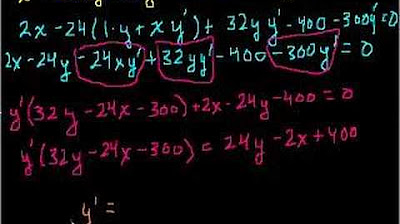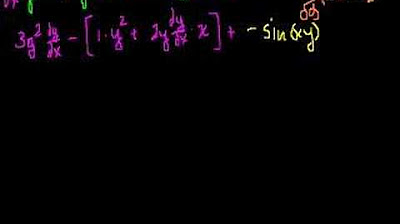Trig Implicit Differentiation Example
TLDRThe video script offers a detailed walkthrough on implicitly differentiating the equation tan(x/y) = x+y, a common challenge for first-year calculus students. The presenter restructures the equation, applies the chain rule systematically, and simplifies the expressions to isolate dy/dx. The explanation emphasizes the chain rule's application in implicit differentiation, transforming a complex problem into a solvable algebraic one, ultimately providing the derivative dy/dx.
Takeaways
- 📚 Implicit differentiation can be challenging for first-year calculus students, but practice with multiple examples helps.
- 🔄 The process involves applying the derivative with respect to x to both sides of the given equation.
- 💡 The derivative of the left side (tangent of b) requires recognizing that a is equivalent to the tangent of b, simplifying the differentiation process.
- 📈 The derivative of the right side (x plus y) is straightforward, yielding 1 + (dy/dx).
- 🌀 The chain rule is crucial for differentiating composite functions, and it naturally applies to implicit differentiation problems.
- 📌 The derivative of a with respect to b is 1/cos^2(b), which is a standard trigonometric derivative.
- 🔢 For the derivative of b with respect to x, rewrite b as x*y^(-1) and apply the product rule to find dy/dx.
- 🔄 When differentiating 1 over y with respect to x, use the chain rule again and treat c as 1 over y to find the derivative.
- 🧩 Solving for dy/dx involves algebraic manipulation, including factoring and dividing terms to isolate dy/dx.
- 🎯 The final step is to divide both sides of the equation by the expression involving dy/dx to solve for it explicitly.
- 📝 The key to implicit differentiation is understanding the chain rule and applying it step by step to simplify and solve for the unknown derivative.
Q & A
What is the main topic of the video script?
-The main topic of the video script is the process of implicitly differentiating the equation tan(y/x) = x + y, which is a common challenge for first-year calculus students.
What is the first step in implicitly differentiating the given equation?
-The first step in implicitly differentiating the given equation is to apply the derivative with respect to x operator to both sides of the equation.
What is the derivative of the right side of the equation with respect to x?
-The derivative of the right side of the equation (x + y) with respect to x is 1, since the derivative of x with respect to x is 1 and the derivative of y with respect to x is treated as an unknown, which we will solve for.
How is the left side of the equation rewritten to simplify the differentiation process?
-The left side of the equation is rewritten by letting a = tan(b) and b = y/x, which allows the differentiation process to focus on the relationship between a and b, and then apply the chain rule to find the derivative of a with respect to x.
What is the chain rule and how is it applied in this context?
-The chain rule states that the derivative of a composite function is the derivative of the outer function times the derivative of the inner function. In this context, it is used to find the derivative of a (tan(b)) with respect to x by first finding the derivative of a with respect to b, and then multiplying by the derivative of b with respect to x.
What is the derivative of tan(b) with respect to b?
-The derivative of tan(b) with respect to b is 1 / (cos(b)^2) or 1 / (cosine squared of b).
How is the derivative of b = x * y^(-1) found?
-The derivative of b with respect to x is found using the chain rule and the product rule. It results in 1 * y^(-1) + (derivative of y with respect to x) * (-1 * x) * y^(-1).
What is the role of the variable c in the script?
-Variable c is introduced as 1/y to simplify the differentiation process of 1/y with respect to x. The derivative of c with respect to x is used to find the relationship between dy/dx and the given variables.
How is the final equation for dy/dx derived?
-The final equation for dy/dx is derived by applying the chain rule multiple times, simplifying the expressions, and then solving for dy/dx by separating the terms involving dy/dx from those that do not.
What is the final form of the implicitly differentiated equation?
-The final form of the implicitly differentiated equation is (1 / y) - (cosine squared of x / y) times (dy/dx) equals (1 + dy/dx), which is solved for dy/dx by dividing both sides by the expression (x / y^2 + cosine squared of x / y).
What is the key takeaway from the video script for solving implicit differentiation problems?
-The key takeaway is that implicit differentiation problems can be solved by applying the chain rule and product rule systematically, and that with practice, the process becomes more intuitive and can be done efficiently.
Outlines
📚 Introduction to Implicit Differentiation
The video begins with the presenter discussing the concept of implicit differentiation, emphasizing its importance in calculus, especially for first-year students. The focus is on the equation tangent of x over y equals x plus y, and the presenter explains that the process involves applying the derivative with respect to x to both sides of the equation. The left side of the equation presents a bit of a challenge, but the right side is straightforward. The presenter introduces a method to simplify the process by rewriting the equation and applying the chain rule, which is a fundamental concept in calculus. The goal is to illustrate that implicit differentiation is not a new or complex concept but rather an application of the chain rule.
🔍 Derivative of Tangent and Application of Chain Rule
In this paragraph, the presenter delves deeper into the derivative of the tangent function and the application of the chain rule. The derivative of the right side of the equation is calculated to be 1, while the left side requires the use of the chain rule. The presenter explains that the derivative of a with respect to b, where a is the tangent of b, and b is x over y, is 1 over the cosine squared of b. The derivative of b with respect to x is then calculated using the product rule, resulting in an expression involving y to the power of negative one and x. The presenter emphasizes the importance of understanding the chain rule and how it naturally leads to the solution of implicit differentiation problems, rather than memorizing a separate set of rules.
🧠 Solving for dy/dx and Finalizing the Implicit Differentiation
The final paragraph focuses on solving for dy/dx, the derivative of y with respect to x. The presenter uses algebraic manipulation to isolate the dy/dx term, applying the chain rule to the derivative of 1 over y with respect to x. The process involves several steps, including multiplying both sides of the equation by the denominator and subtracting terms to isolate dy/dx on one side. The presenter then factors out dy/dx from the right side of the equation and divides both sides by the resulting expression to solve for dy/dx. The explanation is detailed, walking through each step of the algebraic process and emphasizing the application of the chain rule throughout the solution. The video concludes with the presenter expressing hope that the detailed walkthrough of the implicit differentiation process is helpful to the viewers, encouraging them to practice and become comfortable with the method.
Mindmap
Keywords
💡Implicit Differentiation
💡Derivative
💡Chain Rule
💡Trigonometric Functions
💡Algebra
💡Rate of Change
💡Sine and Cosine
💡Product Rule
💡Critical Points
💡Limits
💡Functions
Highlights
The main topic discussed is implicit differentiation, specifically focusing on the equation tan(x/y) = x + y.
Implicit differentiation is a common challenge for first-year calculus students.
The process involves applying the derivative with respect to x operator to both sides of the equation.
The derivative of the right side of the equation is straightforward, while the left side requires more attention.
The video provides an example of rewriting the equation to facilitate the differentiation process, using a and b as substitutes for tan(b) and b = x/y respectively.
The chain rule is fundamental to solving this problem and is emphasized throughout the explanation.
The derivative of tan(b) with respect to x is found using the chain rule, which leads to the derivative of a with respect to b times the derivative of b with respect to x.
The derivative of b with respect to x is calculated using the product rule, resulting in a complex expression.
The derivative of 1/y with respect to x is determined by applying the chain rule again, leading to a further breakdown of the expression.
The process simplifies the complex derivative expression by combining like terms and applying algebraic techniques.
The final step is to solve for dy/dx, which is the main goal of the implicit differentiation.
The video emphasizes that implicit differentiation problems can be approached using the chain rule and algebraic techniques, rather than memorizing specific rules.
The example provided is a comprehensive walkthrough of implicit differentiation, demonstrating the application of the chain rule at every step.
The video aims to demystify implicit differentiation by showing that it is a natural application of the chain rule and algebra, rather than a separate, complex topic.
The transcript provides a detailed explanation of the steps involved in implicit differentiation, making it a valuable resource for students and educators.
The video concludes with a summary of the process, emphasizing the transition from complex derivative expressions to a solvable algebraic equation for dy/dx.
Transcripts
5.0 / 5 (0 votes)
Thanks for rating:





